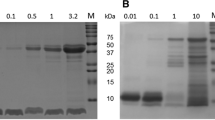Abstract
Many enzymes used as digestive aids exhibit, at best, moderate stability when incubated under gastrointestinal conditions. A supplemental β-galactosidase administered orally to treat lactose intolerance was conjugated to 40 kDa, branched polyethylene glycol (PEG). PEGylation increased the enzyme’s relative activity at lower pH values (2.5–4.5) and doubled enzyme stability at pH 2.5. The PEGylated enzyme retained significantly more residual activity after exposure to simulated gastric conditions (52% versus 31%), a consequence of protection from both pepsin and low pH mediated inactivation. Conjugation also provided significant protection against the proteolytic component of pancreatin. Overall, the PEGylated enzyme retained over twice the levels of residual activity recorded for non-PEGylated enzyme after exposure to complete simulated gastrointestinal conditions. PEGylation also marginally improved the enzyme’s kinetic characteristics. When using its physiological substrate (lactose), Km values recorded were slightly decreased (from 83 to 60 μM) and kcat/Km values (M−1 s−1) were increased from 100 to 147. This appears to be the first report of the use of a conjugated PEG to stabilize a digestive enzyme and the first report of the ability of conjugated PEG to stabilize a protein at low pH.


Similar content being viewed by others
References
Bedford M, Partridge G (2001) Enzymes in farm animal nutrition. CABI publishing, Oxford, UK
Kurfurst MM (1992) Detection and molecular weight determination of polyethylene glycol-modified hirudin by staining after sodium dodecyl sulfate-polyacrylamide gel electrophoresis. Anal Biochem 200:244–248
O’Connell S (2006) Additional therapeutic enzymes. In: McGrath B, Walsh G (eds) Directory of therapeutic enzymes. Tailor and Francis, Florida, pp 261–290
O’Connell S, Walsh G (2006) Physicochemical characteristics of commercial lactases relevant to their application in the alleviation of lactose intolerance. App Biochem Biotechnol 134:179–191
O’Connell S, Walsh G (2007) Purification and properties of a beta-galactosidase with potential application as a digestive supplement. App Biochem Biotechnol 141:1–13
O’Connell S, Walsh G (2008) Application relevant studies of fungal beta-galactosidases with potential application in the alleviation of lactose intolerance. App Biochem Biotechnol 149:129–138
Pasut G, Veronese FM (2007) Polymer-drug conjugation, recent achievements and general strategies. Prog Polym Sci 32:933–961
Ryttersgaard CL, Lo Leggio P, Coutinho M, Henrissat B, Larsen S (2002) Aspergillus aculeatus beta-1,4-galactanase: substrate recognition and relations to other glycoside hydrolases in clan GH-A. Biochemistry 41:15135–15143
Swagerty DL, Walling AD Jr, Klein RM (2002) Lactose intolerance. Am Fam Physician 65:1845–1850
Veronese FM (2001) Peptide and protein PEGylation: a review of problems and solutions. Biomaterials 22:405–417
Veronese FM, Caliceti P, Schiavon O (1997) Branched and linear poly(ethylene glycol): influence of the polymer structure on enzymological, pharmacokinetic, and immunological properties of protein conjugates. J Bioact Compat Pol 12(3):196–207
Veronese FM, Sacca B, de Laureto PP, Sergi M, Caliceti P, Schiavon O, Orsolini P (2001) New PEGs for peptide and protein modification, suitable for identification of the PEGylation site. Bioconjugate Chem 12(1):62–70
Wang H, Lou H, Bai Y, Wang Y, Yang P, Shi P, Zhang W, Fan Y, Yao B (2009) An acidophilic β-Galactosidase from Bispora sp. MEY-1 with high lactose hydrolytic activity under simulated gastric conditions. J Agric Food Chem 57:5535–5541
Xenos K, Kyroundis S, Anagnostidis A, Papastathopoulos P (1998) Treatment of lactose intolerance with exogenous beta-D-galactosidase in pellet form. Eur J Drug Metab 23(2):350–355
Zheng C, Ma G, Su Z (2007) Native PAGE eliminates the problem of PEG-SDS interaction in SDS-PAGE and provides an alternative to HPLC in characterization of protein PEGylation. Electrophoresis 28(16):2801–2807
Acknowledgments
Work funded in part by the Irish Research Council for Science, Engineering and Technology.
Author information
Authors and Affiliations
Corresponding author
Electronic supplementary material
Below is the link to the electronic supplementary material.
Rights and permissions
About this article
Cite this article
Turner, K.M., Pasut, G., Veronese, F.M. et al. Stabilization of a supplemental digestive enzyme by post-translational engineering using chemically-activated polyethylene glycol. Biotechnol Lett 33, 617–621 (2011). https://doi.org/10.1007/s10529-010-0474-7
Received:
Accepted:
Published:
Issue Date:
DOI: https://doi.org/10.1007/s10529-010-0474-7




